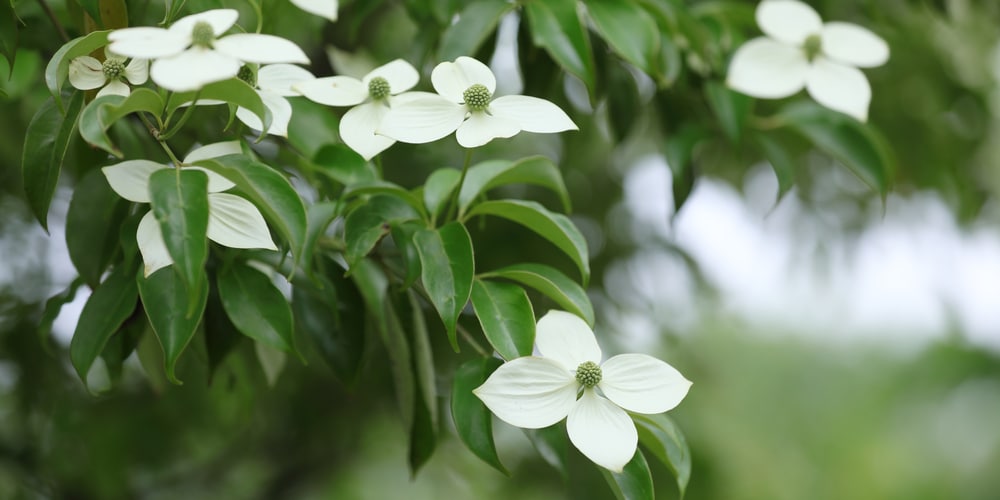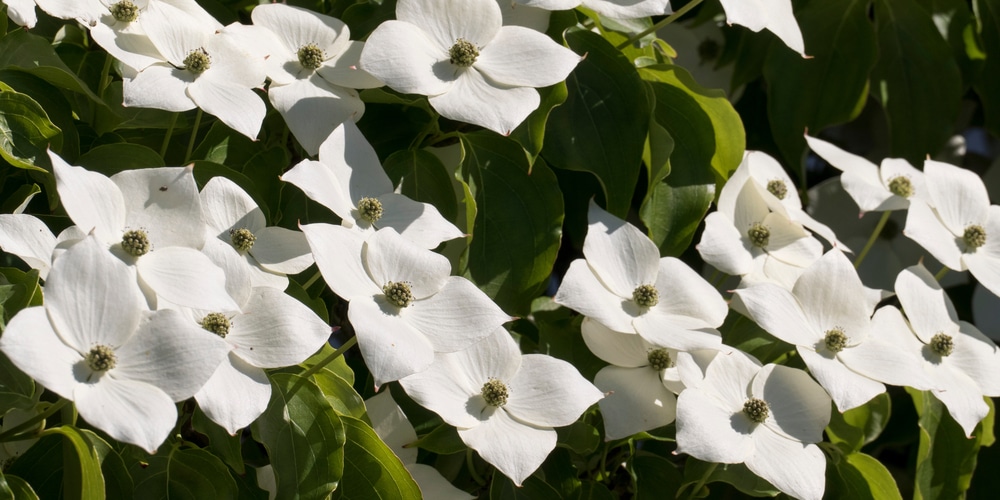Dogwoods are beautiful ornamental trees that prefer rich soil, shade, and most importantly, regular fertilization of the right kind and amount.
Here’s a short guide on what, when and how you should fertilize your dogwood tree.
Dogwood Tree Fertilizer – What is the Right Type?

Dogwood trees prefer warm and pleasant weather and thrive in USDA zones 5 through 9. Although they can withstand full sun in lower zones they prefer to live in part-shade and typically under the protection of structures and other tall trees.
Fertilization is an important aspect of a tree’s growth, and the dogwood is no exception. The problem is, not all fertilizers you see in the market are good for them.
Plants in general benefit from three main elements- nitrogen, phosphorus and potassium. Nitrogen is usually the most important as it dictates the tree’s overall health and growth, closely followed by phosphorus (for flowering) and potassium (for the roots).
For dogwood trees, having a higher ratio of nitrogen usually works- it’s recommended that you get either a 12-4-8 fertilizer or a 16-4-8 fertilizer for your dogwood.
The good news is that both fertilizer varieties can be found in most garden stores and nurseries. Having a greater amount of nitrogen will prove to be beneficial for dogwoods as it encourages photosynthesis, while phosphorus supplies energy and potassium helps with cell division.
A 16-4-8 fertilizer is recommended for yards and gardens that are nitrogen-deficient. Dogwoods prefer slightly acidic soil that has an abundance of nutrients- if it’s possible to conduct a soil test, do so before applying any kind of fertilizer.
You’ll notice if the dogwood needs more fertilizer when the leaves appear to be light green and it seems to be surviving rather than growing.
When to Fertilize a Dogwood Tree?
Timing is just as important as application when you’re fertilizing a dogwood tree. Generally you’ll want to fertilize during the growing season to promote new leaves, branches and flowers.
Dogwood trees are weak against cold and will go into hibernation when winter comes. During this time, minimal watering and fertilization should be observed since the plant is in ‘rest mode’.
Dogwood owners should not fertilize their trees in fall, as new growth is likely to succumb to frost in the next season. You will have wasted your time and money with the fertilizer.
That said, the best time to fertilize a dogwood tree is in mid-spring or late spring. This is the time when dogwoods grow and form new stems and leaves, as well as flowers.
You can boost the plant’s effort with a 16-4-8 fertilizer for soil that needs extra nitrogen content, or a lower 12-4-8 if there’s still some trace nutrients on the ground or container.
It’s worth noting that you shouldn’t fertilize young dogwood trees. The reason behind this is that the plant’s roots are very sensitive, and too much nitrogen can burn the roots rather than help them.
Leave your dogwood tree as is and only water during its first year. If you must, only apply organic material such as mulch or organic tea that’s half-strength for young dogwoods but it’s not really necessary.
As long as they’re in the best location in your yard or garden and getting the watering they need then your dogwood tree should flourish.
With the right care your dogwood shouldn’t pose any problems and will grow strong and healthy. Deep green leaves and a profusion of blooms in late spring or summer is a sign that you’re doing good.
How to Fertilize a Dogwood Tree
It’s generally a good idea to fertilize your dogwood as soon as spring arrives, then three months after that. It ties in with the plant’s growth period and allows it to develop new stems and leaves.
Skip the first growing period of a young dogwood tree to allow the roots to establish and spread underground. If you forgot to take count, then wait until the dogwood is around 6 feet or 2 meters tall.
For this height and maturity it’s recommended that you use 2 ounces, or one-fourth cup of 12-4-8 fertilizer come springtime and three months after. Mature dogwoods, or those two or three years old can benefit from a half cup, or 4 ounces of fertilizer per inch of trunk.
As far as application is concerned, you won’t need to put it too close to the trunk. Once you’ve measured the right amount of granular or general-purpose fertilizer then you should spread it under the tree’s canopy, and also at the drip line.
The dripline can be found a few inches outside the tree branch circumference and is called as such because it naturally gets wet after rain.
After applying dogwood fertilizer you can apply an inch or two of water where you placed the fertilizer to make it seep to the ground (and the tree roots).
Mature dogwood trees can be fertilized, albeit in a different way. Count up to a hundred square feet from the trunk and apply the 12-4-8 fertilizer there.
It’s recommended that you dig an inch or two before putting the granules in, then watering an inch or so for the roots to absorb it.
Dogwood trees are hardy and can survive a drought or two, as long as they’re in a shaded area and get constant nutrients from the soil.
It’s generally okay to fertilize your dogwood only once per growing season, but you won’t see a lot of blooms. Incorrect fertilization in type or application can lead to root burn and be detrimental to the plant.
Fertilizing a dogwood tree once a month is not recommended. When this happens, you should flush out the excess salts with a thorough watering- turn on the hose and apply for a good 5 or 10 minutes. Then, keep in mind the dogwood’s age and fertilizer type for the best results.
Dogwood Tree Fertilizer: Conclusion
You can leave out fertilizing your dogwood tree if it’s near a garden or other plants that get regularly fertilized.
There’s a good chance that it’s getting the excess nutrients from runoff whenever you water, and it should be more than enough for what the tree needs.
Related Article: Dogwood Trees Zone 9

